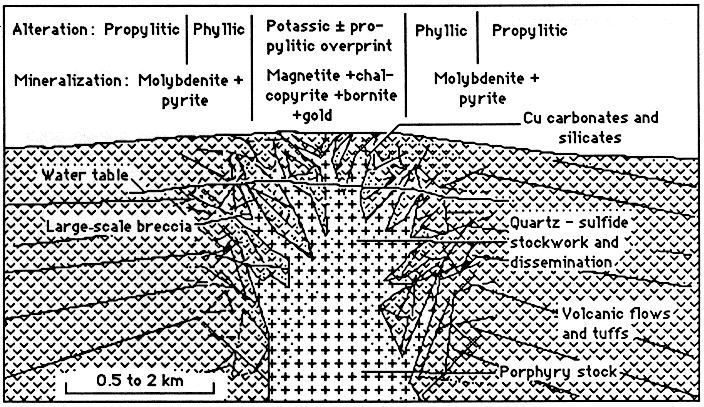
DESCRIPTIVE MODEL OF PORPHYRY Cu-Au
MODEL 20c
By Dennis P. Cox
DESCRIPTION Stockwork veinlets of chalcopyrite, bornite, and magnetite in porphyritic intrusions and coeval volcanic rocks. Ratio of Au (ppm) to Mo (percent) is greater than 30 (see fig. 77).
Figure 77. Cartoon cross section of porphyry Cu-Au deposit. Modified from Langton and Williams (1982).

GENERAL REFERENCES Sillitoe (1979), Cox and Singer (in press).
GEOLOGICAL ENVIRONMENT
Rock Types Tonalite to monzogranite; dacite, andesite flows and tuffs coeval with intrusive rocks. Also syenite, monzonite, and coeval high-K, low-Ti volcanic rocks (shoshonites).
Textures Intrusive rocks are porphyritic with fine- to medium-grained aplitic
groundmass.
Age Range Cretaceous to Quaternary.
Depositional Environment In porphyry intruding coeval volcanic rocks. Both involved and in large-scale breccia. Porphyry bodies may be dikes. Evidence for volcanic center; 1-2 km depth of emplacement.
Tectonic Setting(s) Island-arc volcanic setting, especially waning stage of volcanic cycle. Also continental margin rift-related volcanism.
Associated Deposit Types Porphyry Cu-Mo; gold placers.
DEPOSIT DESCRIPTION
Mineralogy Chalcopyrite ± bornite; traces of native gold, electrum, sylvanite, and hessite. Quartz + K-feldspar + biotite + magnetite + chlorite + actinolite + anhydrite. Pyrite + sericite + clay minerals + calcite may occur in late-stage veinlets.
Texture/Structure Veinlets and disseminations.
Alteration Quartz ± magnetite ± biotite (chlorite) ± K-feldspar ± actinolite, ± anhydrite in interior of system. Outer propylitic zone. Late quartz + pyrite + white mica ± clay may overprint early feldspar-stable alteration.
Ore Controls Veinlets and fractures of quartz, sulfides, K-feldspar magnetite, biotite, or chlorite are closely spaced. Ore zone has a bell shape centered on the volcanic-intrusive center. Highest grade ore is commonly at the level at which the stock divides into branches.
Weathering Surface iron staining may be weak or absent if pyrite content is
low in protore. Copper silicates and carbonates. Residual soils contain anomalous amounts of rutile.
Geochemical Signature Central Cu, Au, Ag; peripheral Mo. Peripheral Pb, Zn, Mn anomalies may be present if late sericite pyrite alteration is strong. Au (ppm):Mo (percent) >30 in ore zone. Au enriched in residual soil over ore body. System may have magnetic high over intrusion surrounded by magnetic low over pyrite halo.
EXAMPLES
Dos Pobres, USAZ (Langton and Williams, 1982)
Copper Mountain, CNBC (Fahrni and others, 1976)
Tanama, PTRC (Cox, 1985)